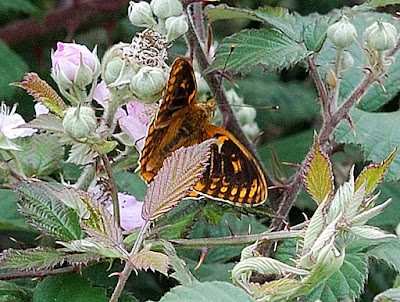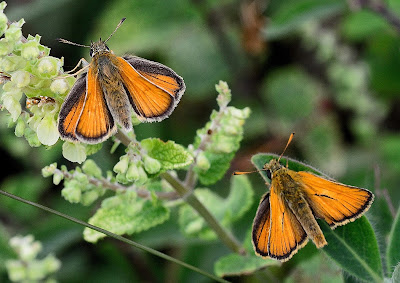The Painted Lady is a regular visitor to the UK although numbers vary greatly from year to year.We can have several broods during the course of the summer and there cannot be a more pleasant sight than a freshly emerged Painted Lady enjoying the sunshine and feeding in a warm flowery location.Therefore today in my local wood it was lovely to see several individuals on bramble and thistle flowers.
Thursday 23 July 2015
Thursday 16 July 2015
The First of Many.
The Chalk-hill Blue can be very prolific on our chalk downland from mid-July to September.A walk along the bridleway to West High Down this afternoon produced a good variety of butterflies but no Chalk-hill Blues.Even on the Down and despite the abundant flowering plants, no Blues.So I had almost resigned myself to another visit in a day or two when returning from the Down along the bridleway the beautiful silvery-blue of a male Chalk-hill in flight caught my eye.He was flying strongly over the drifts of Hemp-agrimony that are just bursting into flower and a definite favourite with many butterflies.
Thursday 9 July 2015
Back on the Downs.
Since my last walk up to West High Down a few days ago the Giant Thistles are now in bloom and attracting a myriad of butterflies,bees,and other insects.Happily,among them are the Dark Green Fritillaries.The promise of rich nectar has slowed them down and they can be observed a little better, now that they are stationary for a few seconds.
With the flush of new flowering plants there is an increase in butterflies especially the Small Skipper.
Wednesday 8 July 2015
That Looks Unusual....
It is always worth taking a closer look at even the common butterflies when out and about.There is a chance that you may be fortunate enough to come across an unusual individual or more correctly an aberration.Most species it seems are prone to aberration and some forms of aberration are classified, but then again many are listed as unclassified.
For a comprehensive list and extensive information on recognized aberrations I would recommend a visit to the excellent website British Butterfly Aberrations.
 |
| Red Admiral ab.bialbata. White spot on red band. |
| A Glanville Fritillary with more black than normal on upper hind wings |
 |
| A Meadow Brown displaying loss of colour over much of its hind wing |
 |
| A Dark Green Fritillary with extensive black on its upper wings. |
Friday 3 July 2015
A Red-letter Day.
The White-letter Hairstreak is a secretive butterfly and relies on the elm tree for its life cycle.Therefore disaster struck when in the 1970s Dutch Elm Disease decimated millions of British elms.Fortunately,the caterpillar can survive on new sucker growth and their recovery has been helped too by the dedicated work of local wildlife and butterfly conservation volunteers who have planted disease resistant elms.
So it was a great day today when I had the opportunity, for the first time, to see these lovely little butterflies.An eagle-eyed friend of mine had seen butterfly activity around such a resistant elm and as they tend to spend much of their time towards the top of the tree obtaining good views of this Hairstreak is difficult.However my luck was in today as several individuals descended to the lower branches to seemingly investigate the elm tree buds.
Tuesday 30 June 2015
Up on the Downs.
On the chalk downs that overlook our south-west coastal stretch there are several species of butterfly that find this habitat to their liking.One such species is the Dark Green Fritillary and now is the time to see the first individuals.This morning I could see them as they rushed around at great speed on the hunt for nectar-rich flowers.One of their favourite plants is the giant thistle although at present there seem to be very few in flower.As they are very partial to this thistle it will be perhaps the best way to get a good look at these fast fliers
Monday 29 June 2015
It's Hotting Up.
With the promise of a heatwave this week the weather today was warm and sunny,and just right to prepare us for soaring temperatures by Wednesday.The butterflies certainly responded to the heat and there were plenty to see in my local copse.From just one Silver-washed Fritillary at the weekend,their numbers had increased to at least six.Also on show are the first White Admirals on the season and whereas the Fritillaries are happy to feed on the bramble and thistle flowers,the Admirals prefer at present to fly around the trees only occasionally coming down to land on the sunny spot.
More Marbled Whites are now in the wood and a real treat was to see a female Purple Hairstreak leave the upper branches of an oak tree to bask in the sun almost at ground level.Many thanks to Andy Butler for the use of his photograph of this hairstreak.
Saturday 27 June 2015
Not Just Another Brown.
Butterfly sightings were somewhat disappointing today along my local forest rides.Plenty of Meadow Browns and Speckled Woods but none of the larger woodland butterflies to see.However the Ringlet is now fluttering about and when in the company of the Meadow Browns it can be tricky to separate the two. In flight the upperside of the Ringlet is a tasty chocolate brown whereas the Meadow Brown is a lighter brown.The Ringlet has no orange on the underside unlike the Brown,just a collection of attractive tri-coloured rings.
Thursday 25 June 2015
Silver-washed Now Back in Our Woodland.
Walking around my local copse this morning on a very sunny and warm start to the day when I saw a solitary male Silver-washed Fritillary on the lookout for the new bramble flowers.Despite several attempts to land it was constantly shooed away by the Meadow Browns.Eventually he managed to evade their attentions and briefly feed from the flowers.
Sunday 21 June 2015
First of the Real Summer Butterflies.
Now that summer is almost upon us the first of the 'summer' butterflies are appearing.That means the Meadow Brown is now on the wing and becoming a common sight in our meadows,woods,and on the downs.In fact why this species is so numerous is because of the diverse habitats this butterfly occupies.Perhaps it is often ignored or taken for granted due to its rather dull colouring and high populations in the countryside.However it is a welcome sign of summertime.
Subscribe to:
Posts (Atom)




















